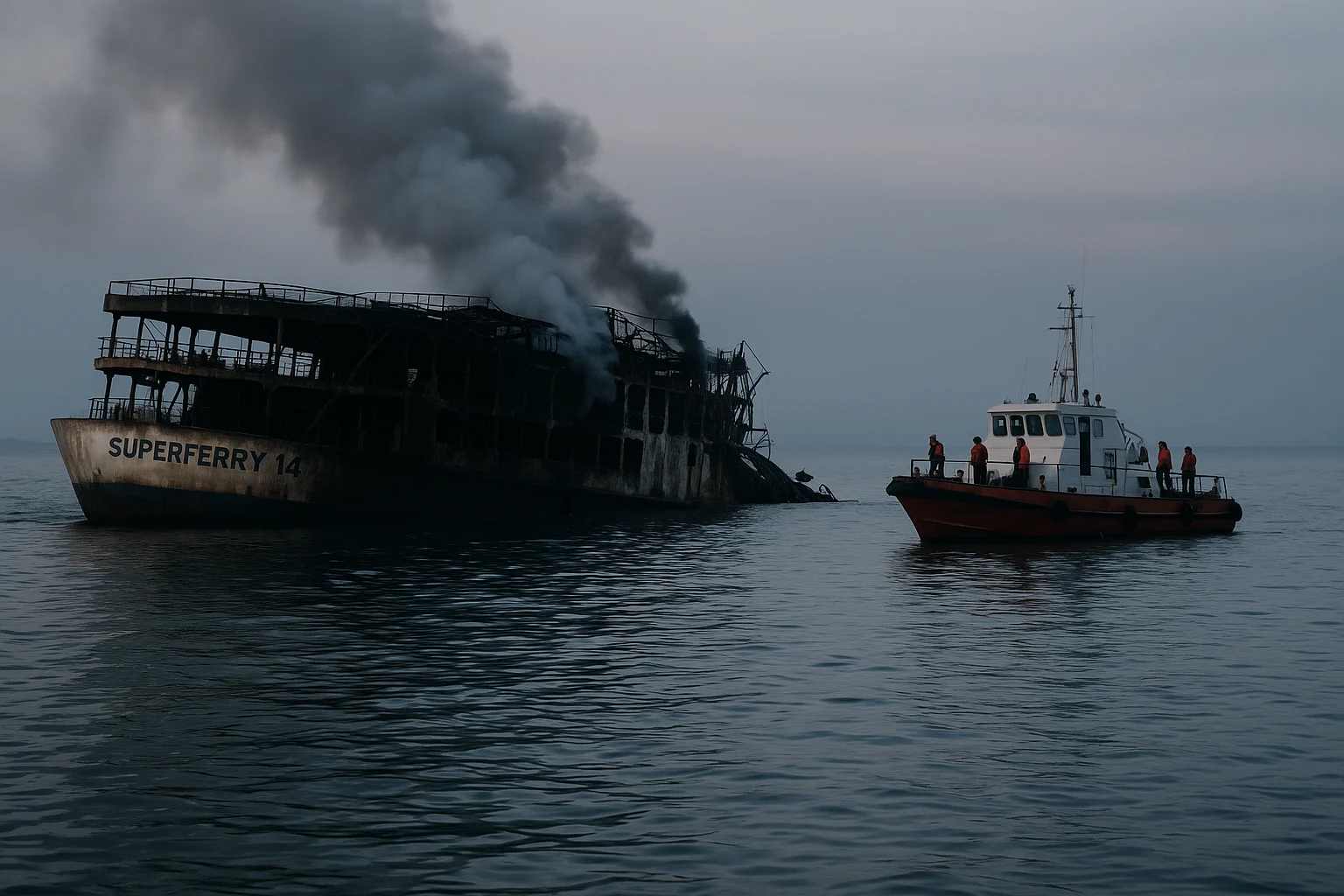
The MV SuperFerry 14 Bombing
by: The Calamity Calendar Team
February 27, 2004
A Journey Shattered
The journey was supposed to be a serene one, typical of the thousands of trips made by the MV SuperFerry 14 each year. On a humid February evening in 2004, nearly 900 passengers and crew members boarded the ferry in Manila, setting sail for distant islands, unaware of the peril lying ahead. In the dim glow of the harbor lights, the ferry pulled away from the bustling city, carrying a mix of weary travelers, excited families, and everyday sailors accustomed to life on the sea. This routine voyage soon spiraled into a nightmare, marking one of the deadliest acts of maritime terrorism the world has seen.
Currents of Tension
The Philippines, a nation composed of over 7,000 islands, heavily relies on ferries as arteries of commerce and connection. Companies like WG&A Philippines, which operated the MV SuperFerry 14, provided a crucial service to a populace spread across vast stretches of water. Yet, beneath this everyday necessity lay an undercurrent of tension. The archipelago nation was, and continues to be, a battleground for internal strife and external machinations, hallmarked by a series of violent incidents perpetrated by Abu Sayyaf.
Abu Sayyaf, a name whispered with fear, had made its presence known through past terror and turmoil. Declaring allegiance to larger extremist networks like al-Qaeda, they vowed to dethrone the government, rejecting any semblance of peace. Their brutal tactics had previously unfolded in kidnappings and bombings, casting shadows over the beautiful islands. However, few anticipated such a catastrophic event making its mark on another vital symbol of the nation — its seas.
The Explosion in the Night
As the clock ticked past midnight, the MV SuperFerry 14 cruised steadily across Manila Bay, unaware that it was heading toward disaster. Amidst the soft lapping of waves, tranquility shattered in an instant as an explosion ripped through the ferry. The blast's origin would later be traced to a seemingly innocuous television set, which concealed eight pounds of TNT, strategically placed by Abu Sayyaf militants in a passenger cabin.
Panic erupted against the backdrop of flickering flames that quickly consumed the ship, transforming it into a floating inferno. As smoke enveloped the ferry, its passengers faced unimaginable choices. In the chaos, many sought solace on the decks, while others plummeted into the dark waters below, seeking refuge from the fire only to confront another perilous element.
A Grim Dawn
By the break of dawn, the scope of devastation became horribly clear. Rescue efforts by the Philippine Coast Guard were underway, yet the scale of destruction had already been etched into the dark waters of Manila Bay. The ferry, now a charred skeleton, bobbed along the currents, a ghostly reminder of its former state.
Thanks for subscribing!
The numbers were staggering, haunting in their finality — 63 lives claimed in the immediacy of the attack, with 53 more souls lost to the sea, their fates sealed in the tumult. Families were left to face the void, grapple with the absence, and reckon with the sudden violent disruption to their lives. The economic toll was immense, too, as the operator, WG&A, calculated their losses not just in monetary terms but also in trust severely fractured.
Arrests and Accountability
In the tragedy's wake, the search for accountability began. Arrests came swiftly, as authorities zeroed in on those responsible. A breakthrough occurred when Redendo Cain Dellosa, a member of Abu Sayyaf, was apprehended. His confession was chilling; he had planted the bomb that led to such horrific loss.
Years later, the legal wheels delivered justice, albeit delayed, as Dellosa was convicted of murder in 2010. He, along with other cohort members, faced the scales of the law for a crime that rocked the nation, sending ripples across the international maritime community.
Ripples of Change
The MV SuperFerry 14 bombing compelled swift and sweeping changes. The event prompted rapid enhancements in port and maritime security — luggage screening processes were tightened, protocols streamlined, and the vigilance of maritime travel heightened. In truth, the attack had not just scorched the ferry but had singed the national consciousness, ensuring that such acts of terror could not strike with such deadly efficiency again.
Echoes of those changes continue to sound today, with ongoing efforts not just in the Philippines but also in collaboration with international partners, focused on securing the vast seas against the malevolence that seeks to exploit them.
A Memory Carved in Water
As years pass, the tragic tale of the MV SuperFerry 14 lingers in collective memory, a story of unexpected innocence shattered by a calculated act of terror. The ferries still ply the waters, threads that weave together the islands of the Philippines, but now under a blanket of ever-watchful security. The legacy of vigilance ensures that while the journey is not forgotten, the paths ahead are safer, honoring those who endured the dark night in Manila Bay.
Stay in the Loop!
Become a Calamity Insider and get exclusive Calamity Calendar updates delivered straight to your inbox.
Thanks! You're now subscribed.